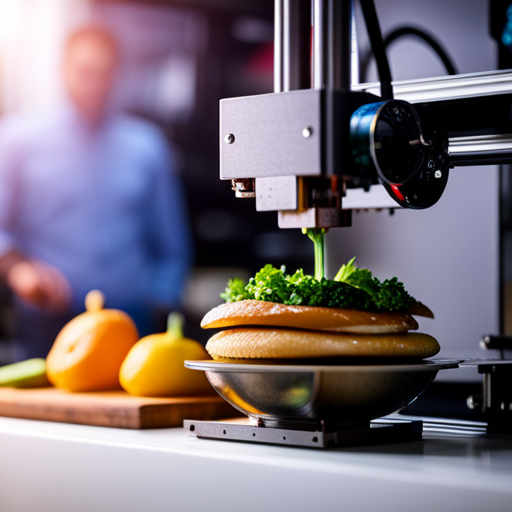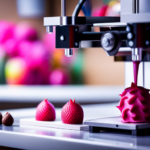Delve into the delectable domain of food 3D printing with this beginner’s guide.
Explore the intricate intersection of technology and gastronomy as we navigate the essential tools, materials, and processes of this innovative culinary craft.
From designing delectable delights to contemplating the future of food fabrication, this article offers a tantalizing taste of the burgeoning world of edible 3D printing.
Understanding Food 3D Printing Technology
Food 3D printing technology enables the creation of edible objects layer by layer using food-based materials. This innovative technology has immense potential in culinary applications, allowing chefs to experiment with unique shapes, textures, and flavors. However, ensuring food safety is paramount when utilizing this technology.
The materials used in food 3D printing must meet strict safety standards to guarantee that the final printed food products are consumable and free from any contaminants. Culinary professionals must carefully select food-grade materials and adhere to hygiene protocols to maintain the highest standards of food safety.
Moreover, the culinary applications of 3D food printing extend beyond mere aesthetics. It allows for the creation of intricate designs and structures that would be challenging to achieve through traditional methods. This opens up new avenues for culinary creativity, enabling chefs to craft visually stunning and precisely engineered dishes.
Understanding the technology and its potential in the culinary world is crucial, but it’s equally important to comprehend the essential tools and materials required for food 3D printing.
Essential Tools and Materials for Food 3D Printing
Utilizing food 3D printing technology in culinary applications requires essential tools and materials to ensure precision and food safety standards are met. When venturing into food 3D printing, it is crucial to have the following tools and materials on hand:
-
Food-Grade 3D Printers: Specialized 3D printers designed for food applications are essential. These printers are constructed using materials that are safe for contact with food and are equipped with features to ensure the precision and reliability required for food printing.
-
Edible Printing Materials: Utilize edible printing materials such as edible pastes, gels, and powders that are specifically designed for 3D food printing. These materials are formulated to meet safety standards and provide the necessary texture and taste for the printed food items.
-
Food-Safe Cleaning Tools: Cleaning tools and solutions that are food-safe are essential for maintaining hygiene and preventing cross-contamination during the 3D printing process.
-
Safety Precautions: Implementing safety measures such as wearing gloves, hairnets, and following proper hygiene protocols is crucial to ensure the safety of the food being printed and the well-being of those involved in the food 3D printing process.
The Process of Food 3D Printing
The food 3D printing process requires careful calibration of the 3D printer’s settings to achieve precise layering and deposition of edible materials. The printing process involves preparing the edible materials, loading them into the printer’s cartridge, and setting the appropriate temperature and speed for extrusion. Troubleshooting tips during the printing process include monitoring the viscosity of the edible materials to ensure consistent flow, adjusting the printer’s temperature to prevent clogging, and checking for any misalignments in the printing layers. It is essential to maintain a clean and sanitized printing environment to avoid contamination of the edible materials during the process.
Additionally, understanding the printer’s capabilities and limitations is crucial for successful food 3D printing. Regular maintenance of the printer, such as cleaning the extruder and replacing worn-out parts, can prevent issues during the printing process. By following these guidelines, one can ensure a smooth and efficient food 3D printing process.
Transitioning into the subsequent section about ‘designing and customizing edible creations,’ it is important to note that the printing process sets the foundation for creating intricate and customized edible designs.
Designing and Customizing Edible Creations
When customizing edible creations with 3D printing, careful consideration of design parameters is essential for achieving precise and intricate results. Designing and customizing edible creations involves several key factors to ensure the successful creation of customized confections and personalized pastries.
Here are four essential considerations to keep in mind:
-
Design Software: Utilize specialized design software that allows for the creation of intricate designs and precise measurements. This software should enable the customization of shapes, textures, and patterns to bring your edible creations to life.
-
Ingredient Compatibility: Consider the ingredients being used and their compatibility with the 3D printing process. Factors such as viscosity, temperature sensitivity, and setting properties are crucial to ensure the success of the printing process and the quality of the final product.
-
Structural Integrity: Pay attention to the structural integrity of the design to ensure that the final product is not only visually appealing but also holds its shape and form. Consider support structures and layering techniques to achieve the desired outcome.
-
Food Safety Regulations: Adhere to food safety regulations and guidelines when customizing edible creations. Ensure that the materials and ingredients used comply with food safety standards and are safe for consumption.
Exploring the Future of Food 3D Printing
Exploring future advancements in food 3D printing involves considering advancements in technology and the potential impact on the customization and production of edible creations. The future applications of food 3D printing are vast and exciting. From personalized nutrition to sustainable food production, the potential for this technology to revolutionize the food industry is immense. However, with these advancements come ethical considerations. Questions arise about the implications of mass production, the use of synthetic ingredients, and the potential impact on traditional culinary practices. It is crucial for the industry to address these ethical concerns to ensure that food 3D printing aligns with societal values and expectations.
| Future Applications | Ethical Considerations | Technological Advancements |
|---|---|---|
| Personalized Nutrition | Mass Production | Enhanced Ingredient Options |
| Sustainable Food Production | Synthetic Ingredients | Improved Printing Speed |
| Culinary Innovation | Impact on Traditional Practices | Enhanced Food Safety Measures |
Frequently Asked Questions
Can Food 3D Printers Be Used to Create Personalized Nutrition Plans Based on an Individual’s Dietary Needs and Restrictions?
Food 3D printers have the potential to create personalized nutrition plans based on individual dietary needs and restrictions. Utilizing 3D printing technology, customized meals can be tailored to meet specific nutritional requirements, offering a novel approach to personalized nutrition.
Are There Any Safety Concerns With Consuming Food That Has Been 3D Printed?
Food safety is a critical consideration when consuming 3D printed food. While the technology offers exciting possibilities for customized nutrition, ensuring the safety of printed food and understanding its environmental impact are important areas of ongoing research and development.
How Does the Taste and Texture of 3D Printed Food Compare to Traditionally Prepared Food?
When comparing 3D printed food to traditionally prepared dishes, the taste is often similar, but the texture may differ. The precision of 3D printing can create unique textures, presenting a novel culinary experience.
Can Food 3D Printing Be Used to Address Food Waste and Sustainability Issues in the Food Industry?
Food 3D printing has the potential to address food waste and sustainability issues in the food industry by enabling personalized portion sizes, reducing food spoilage, and using alternative ingredients to minimize environmental impact. Customized nutrition can also cater to specific dietary restrictions.
Are There Any Cultural or Ethical Considerations to Keep in Mind When Using Food 3D Printing Technology?
Cultural considerations and ethical implications are critical when using food 3D printing technology. Understanding dietary restrictions, respecting traditional food practices, and ensuring fair labor practices are crucial. Balancing innovation with cultural sensitivity is essential.
Conclusion
In conclusion, food 3D printing technology offers a revolutionary way to create customized edible creations.
The process involves using essential tools and materials to design and customize food items.
The future of food 3D printing holds great potential for transforming the way we think about food production and consumption.
As the saying goes, ‘the sky’s the limit’ when it comes to the possibilities of this innovative technology.


